NBCOT COTA EXAM Questions and Answers
Document Content and Description Below
Anterolateral hip replacement precautions - ANSWER Hip extension, hip adduction, and hip external rotation Common observable clinical signs of dysphagia - ANSWER Drooling, pocketing of food in the ... mouth, coughing, or a gurgly speech. Contraindicated foods for clients with dysphagia - ANSWER Items such as dry foods (bread, crackers, chips), chewy foods (meat, candy), thin liquids (water, soda), and food with mixed consistencies (casseroles, soups) Aphasia - ANSWER Absence of cognitive language processing ability which results in deficits in speech, writing, or sign communication. Can be receptive, expressive, or both. Anomia - ANSWER Loss of ability to name objects or to to recognize or recall names; can be receptive of expressive (type of aphasia) Broca's aphasia - ANSWER Expressive aphasia- difficulty speaking Wernicke's aphasia - ANSWER Receptive aphasia- difficulty understanding language Common problems after cerebellum strokes - ANSWER Abnormal reflexes of the head and torso, coordination, and balance problems, dizziness, problems with swallowing and articulation, and cranial nerve deficits Common problems after brainstem stroke - ANSWER Strokes in the brainstem are often life threatening because the brainstem is the control center for essential life functions such as breathing, heart rate, blood pressure, and arousal. As with cerebellum stroke, survivors of brainstem stroke may also present with dizziness, problems with swallowing and articulation, cranial nerve deficits, and paralysis Left-sided CVA - ANSWER MOTOR- Right-sided paralysis/paresis, decreased motor control of repetitive movements (dysphagia *) / SENSORY- Right-sided sensory loss / VISUAL- Right visual field cuts (visual neglect) / PERCEPTUAL- Impaired right/left discrimination, verbal apraxia (hemi-inattention, motor apraxia) / COGNITIVE- Decreased analytic thinking, impaired logic, impaired time concepts, impaired memory associated with language / BEHAVIORAL- Slow performance, cautious behavior, depression / SPEECH AND LANGUAGE- Aphasia, agraphia, dyscalculia, decreased understanding of gestures, impaired reading, decreased ability to learn new information Right-sided CVA - ANSWER MOTOR- Left-sided paralysis/paresis, more severe motor problems, decreased motor response time (dysphagia) / SENSORY- Left-sided sensory loss / VISUAL- Left field cuts, visual neglect / PERCEPTUAL- Unilateral neglect, hemi-inattention, motor apraxia, constructional apraxia, dressing apraxia, agnosia, disorientation for directionality, difficulty crossing midline / COGNITIVE- Impaired attention span, impaired understanding of the whole, decreased creativity, impaired memory for performance, poor insight, poor safety awareness, poor judgment / BEHAVIORAL- Impulsivity, emotional lability / SPEECH AND LANGUAGE- Decreased ability to differentiate between gestures, decreased learning for familiar (old) information ZPP - ANSWER Zone of partial preservation- Incomplete SCI Spinal nerves and major parts of body they supply - ANSWER C1-C3 (head and neck), C4 (diaphragm), C5 (deltoids, biceps), C6 (wrist extensors), C7 (triceps), C8-T1 (hand), T2-T7 (chest muscles), T8-T12 (abdominal muscles), L1-L5 (leg muscles), S2-S5 (bowel, bladder, sex) ASIA A - ANSWER Complete lesion. No motor or sensory function preserved in the sacral segments S4-S5 ASIA B - ANSWER Incomplete lesion. Sensory but not motor function is preserved below the neurological level and includes the sacral segments S4-S5 ASIA C - ANSWER Incomplete lesion. Motor function is preserved below the neurological level, and more than half of the key muscles below the neurological level have a muscle grade less than 3 ASIA D - ANSWER Incomplete lesion. Motor function is preserved below the neurological level, and at least half of the key muscles below the neurological level have a muscle grade of 3 or more ASIA E - ANSWER Indicates that motor and sensory functions are normal Central Cord Syndrome - ANSWER Usually the result of a hyperextension injury in the cervical region when there is more cellular destruction in the center of the chord than in the periphery. Paralysis and sensory loss are greater in the UEs because these nerve tracks are more centrally located than nerve tracks for the LEs. This syndrome is often seen in older people in whom arthritic changes or developing stenosis have caused narrowing of the spinal canal; in such cases cervical hyperextension without vertebral fracture may precipitate CCS Brown-Sequard Syndrome (Lateral Damage) - ANSWER Results when only one side of the cord is damaged, as in a stabbing or gunshot injury. Motor paralysis and deficits in kinesthesia and proprioception occur below the level of injury, on the ipsilateral side. Loss of pain, temperature, and touch sensation occurs on the contralateral side. Anterior Spinal Cord Syndrome - ANSWER Usually the result of a flexion injury in the cervical region that damages the anterior spinal artery or the anterior aspect of the cord. This syndrome involves paralysis and loss of pain, temperature, and touch sensation. Proprioception is preserved. Cauda Equina (Peripheral) - ANSWER Cauda equina injuries involve peripheral nerves rather than directly involving the spinal cord. This usually occurs with fractures below the L2 level and results in a flaccid-type-paralysis. Because peripheral nerves possess a regenerating capacity that the cord does not, prognosis for recovery is better with this injury. Patterns of sensory and motor deficits are highly variable and asymmetrical. Posttraumatic Period after SCI - ANSWER Spinal shock that may last from 24 hours to 6 weeks. Areflexia, flaccid bowel and bladder, decreased deep tendon reflexes, and disturbed sympathetic functions. This causes constriction of the blood vessels, low blood pressure, slower heart rate, and no perspiration below the level of injury. Innervated muscles below the level of injury usually develop spasticity because the monosynaptic reflex arc is intact but separated from higher inhibitory influences. Deep tendon reflexes become hyperactive, and spasticity may be evident. Sensory loss continues, and the bladder and bowel usually become spastic (upper motor neuron bladder) in patients whose injuries are above T12. The bladder and bowel become flaccid (lower motor neuron bladder) in patients whose lesions are at L1 and below. Prognosis for Recovery after SCI - ANSWER If there is no sensation or return of motor function below the level of lesion 24 to 48 hours after the injury in carefully assessed complete lesions, motor function is less likely to return. However, partial to full return of function to one spinal root level below the the fracture can be gained and may occur in the first 6 months after injury. In incomplete lesions, progressive return of motor function is possible, but unpredictable. The longer it takes for recovery to occur the less likely it is that it will occur (usually first few weeks) Portable immobilization for cervical injuries and high thoracic (T1-T4) - ANSWER Halo vest or cervical collar (allows the patient to be up in a wheelchair and involved in an active therapy program in as little as 1 to 2 weeks after injury) Portable immobilization for thoracic injuries - ANSWER Thoracic collar, brace, or body jacket (allows the patient to be up in a wheelchair and involved in an active therapy program in as little as 1 to 2 weeks after injury) Skin breakdown, Pressure Sores, or Decubitus Ulcers - ANSWER Pressure causes the loss of blood supply to the area, which can ultimately result in necrosis below the area of the skin. The areas most likely to develop skin breakdown are bony prominences. At first the area reddens yet blanches when pressed. Later, the reddened or abraded area does not blanch, which indicates that necrosis has began. Finally, a blister or ulceration appears in the area. Often the problem is more severe below the area of the skin surface. If allowed to progress, a sore can become severe, destroying underlaying tissue even as deep as the bone. Skin damage can develop within 30 minutes. Decreased vital capacity after SCI - ANSWER In people who have sustained cervical and high thoracic lesions, limited chest expansion and decreased ability to cough because of weakness or paralysis of the diaphragm and the intercostal and latissimus dorsi muscles, which can cause a tendency to develop infections of the respiratory tract. Strengthening of the sternocleidomastoids and the diaphragm, manually assisted coughing, and deep breathing exercises are essential to maintain optimal vital capacity Osteoporosis after SCI - ANSWER Is likely to develop in patients with SCIs because of disuse of long bones, particularly of the LEs. Osteporosis may be sufficiently advanced for pathological fractures to occur a year after injury, usually of the LEs. Daily standing with a standing frame may sow the onset of osteoporosis; however, this method is controversial and is not embraced in all rehabilitation programs Orthostatic Hypotension - ANSWER A lack of muscle tone in the abdomen and LEs leads to pooling of blood in these areas, with a resultant decrease in blood pressure (hypotension). This problem occurs when the patient moves from a supine to upright position or changes body position too quickly. Symptoms are dizziness, nausea, and loss of consciousness. The patient must be reclined quickly and, if sitting in a WC, tipped back with legs elevated until symptoms subside. With time this problem can diminish as sitting tolerance and level of activity increase. Abdominal binders, compression garments, anti embolism stockings, and medications and aid in reducing symptoms Autonomic dysreflexia - ANSWER A life threatening phenomenon that occurs in persons with spinal chord injuries above T4 to T6 level. It is caused by reflex action of the autonomic nervous system in response to some stimulus such as distended bladder, fecal mass, bladder irritation, rectal manipulation, thermal or pain stimuli, or visceral distention. (It can occur at any time after the injury) http://images.main.uab.edu/spinalcord/SCI%20Infosheets%20in%20PDF/Autonomic%20Dysreflexia.pdf Symptoms of autonomic dysreflexia - ANSWER Immediate pounding headache, anxiety, perspiration, flushing, chills, nasal congestion, sudden onset of hypertension, and bradycardia How is autonomic dysreflexia treated? - ANSWER By placing the patient in an upright position and removing anything restrictive such as abdominal binders or elastic stockings to reduce blood pressure. The bladder should be drained, or the legbag tubing should be checked for obstruction. Blood pressure and other symptoms should be monitored until they return to normal. Spasticity after SCI - ANSWER An involuntary muscle contraction below the level of injury that result from lack of inhibition from the brain. Patterns of spasticity change over the first year, gradually increasing in the first 6 months and reaching a plateau about 1 year after the injury. A moderate amount of spasticity can be helpful in the overall rehabilitation of the patient, such as for maintaining muscle mass, assist in the prevention of pressure sores by facilitating blood circulation, and can assist in ROM and bed mobility. A sudden increase in spasticity can alert the patient to other medical problems such as bladder infections, skin breakdown, or fever Heterotopic ossification (HO) - ANSWER Also called ectopic bone, is bone that develops in abnormal anatomic locations. It most often occurs in the muscles around the hip and knee, but occasionally it can be noted at the elbow and shoulder. Symtoms of heterotopic ossification (HO) - ANSWER The first symptoms are swelling, warmth, and decreased joint ROM. The onset of HO is usually 1 to 4 months after injury (SCI). Treatment of heterotopic ossification (HO) - ANSWER It consists of medication and the maintenance of joint ROM during the early stage of active bone formation, to preserve the functional ROM necessary for good wheelchair positioning, symmetrical position of the pelvis, and maximal functional mobility. [Show More]
Last updated: 3 weeks ago
Preview 1 out of 5 pages
Instant download

Buy this document to get the full access instantly
Instant Download Access after purchase
Add to cartInstant download
Reviews( 0 )
Document information
Connected school, study & course
About the document
Uploaded On
Aug 23, 2022
Number of pages
5
Written in
Additional information
This document has been written for:
Uploaded
Aug 23, 2022
Downloads
0
Views
77


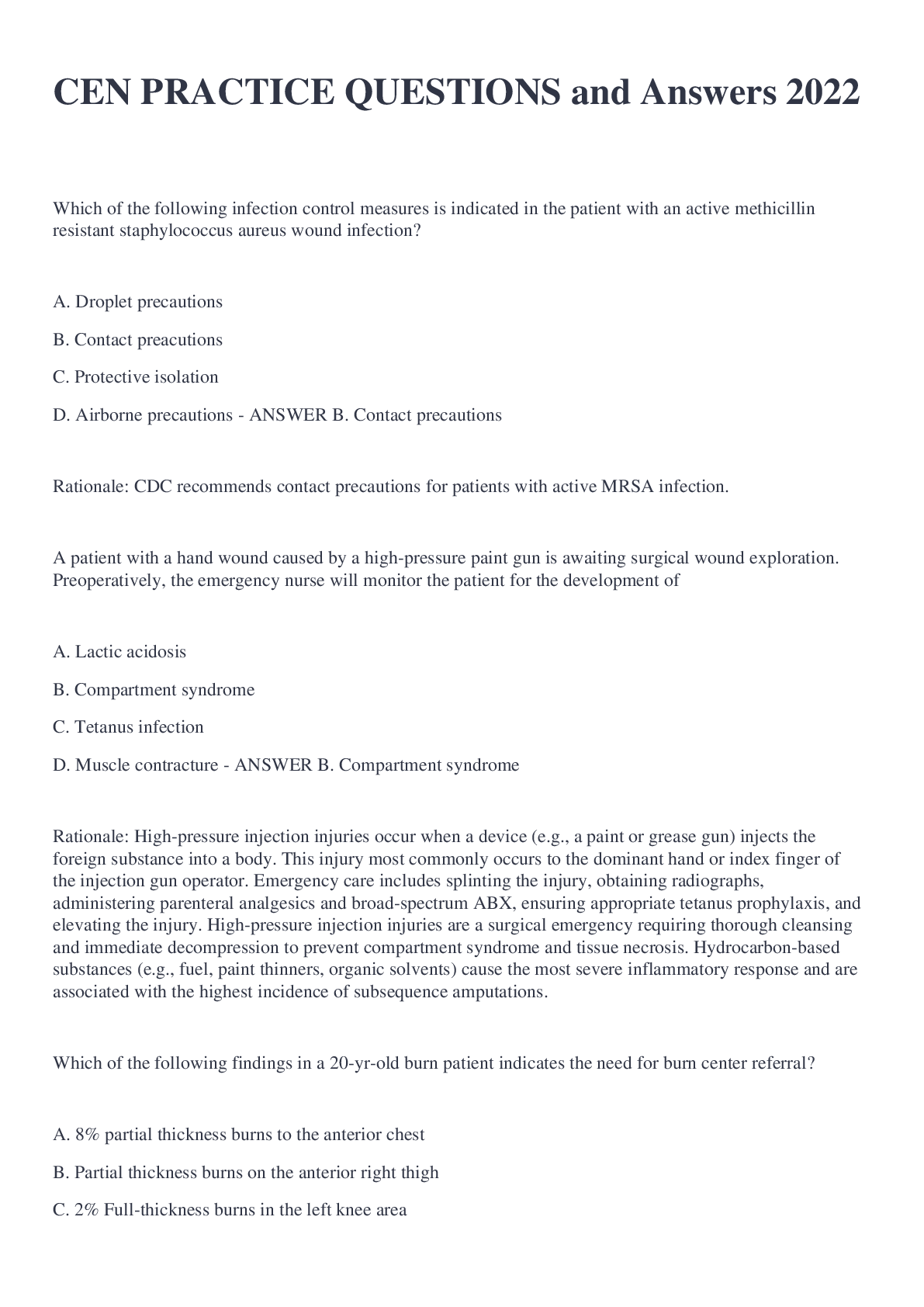

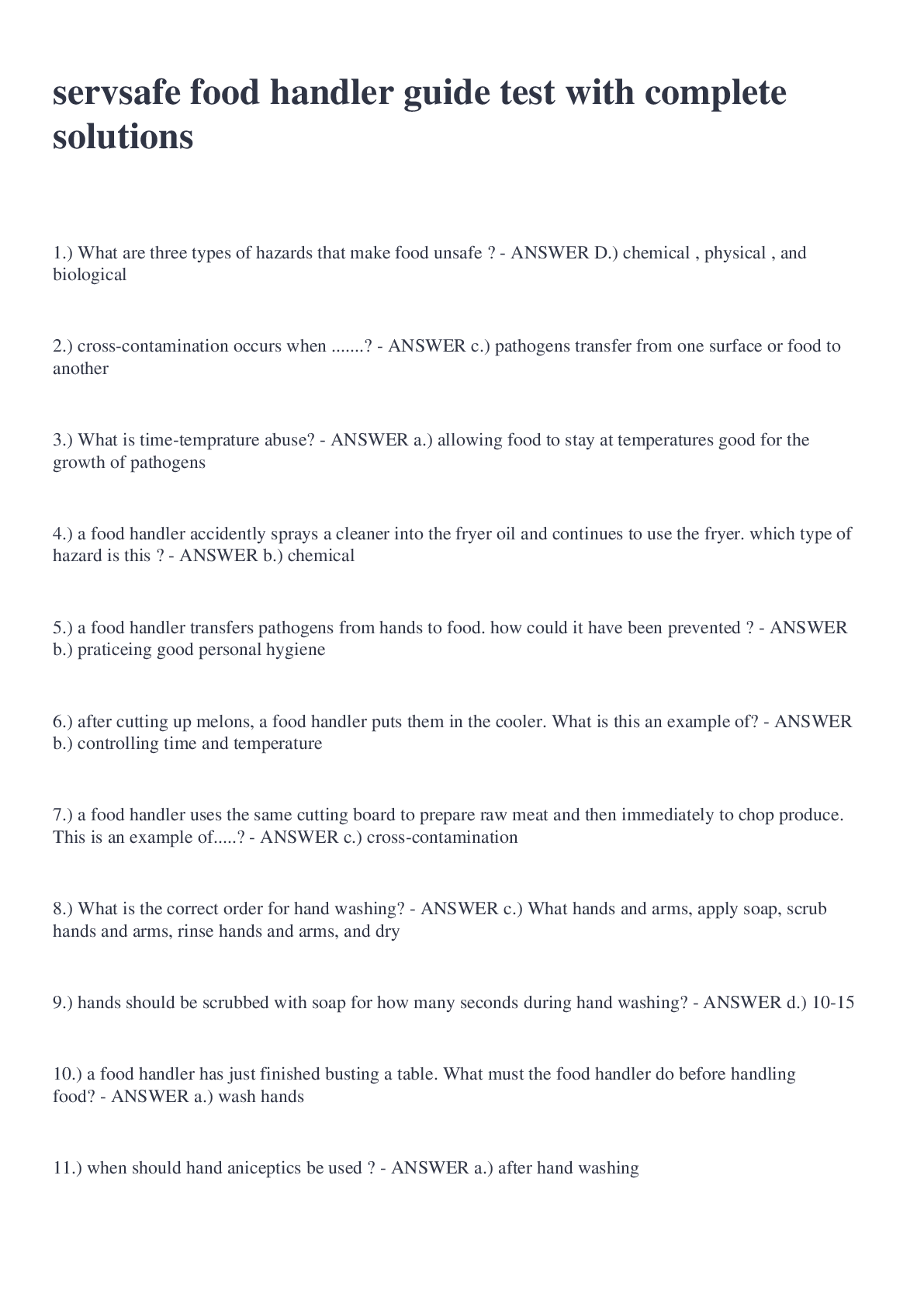


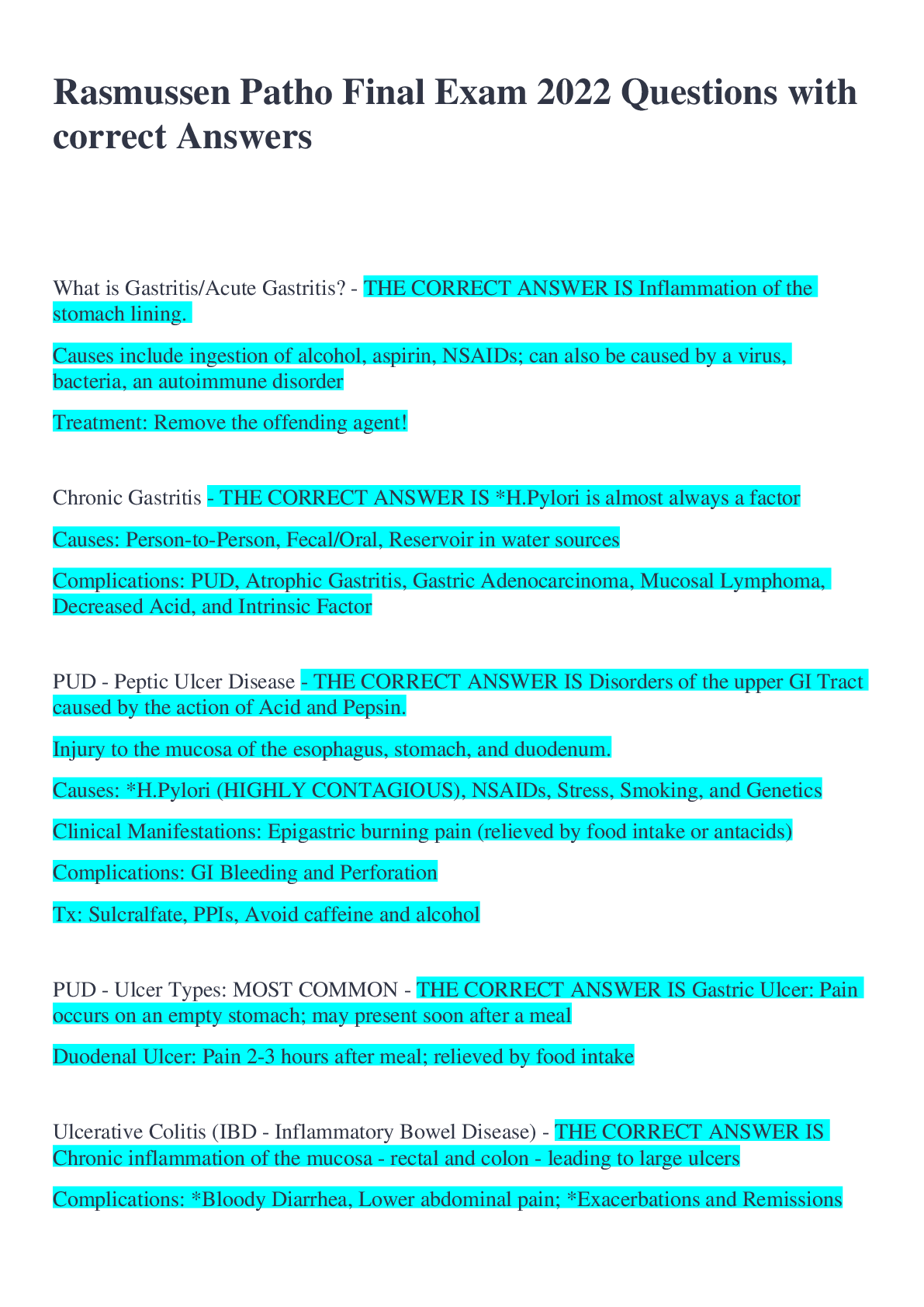
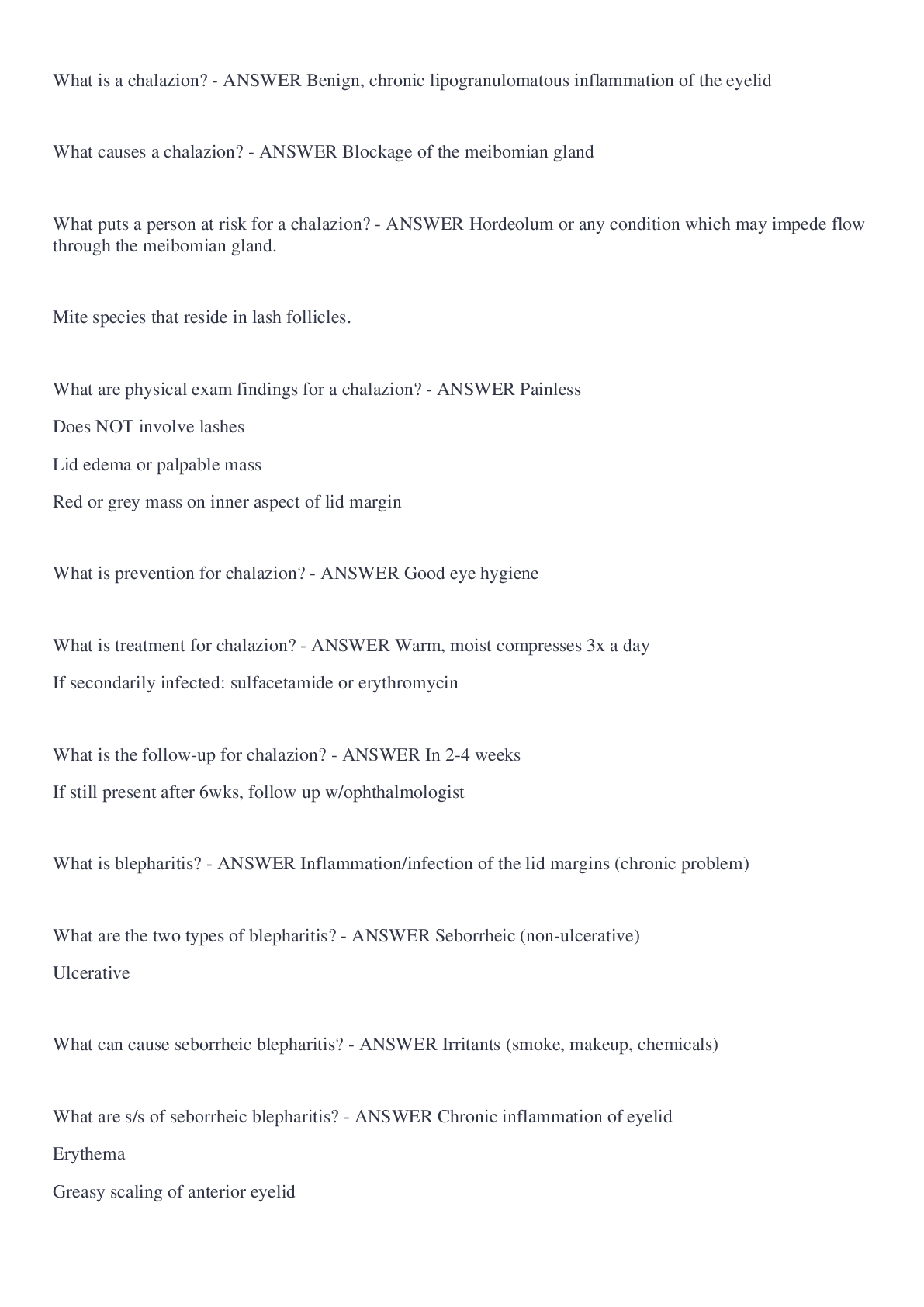
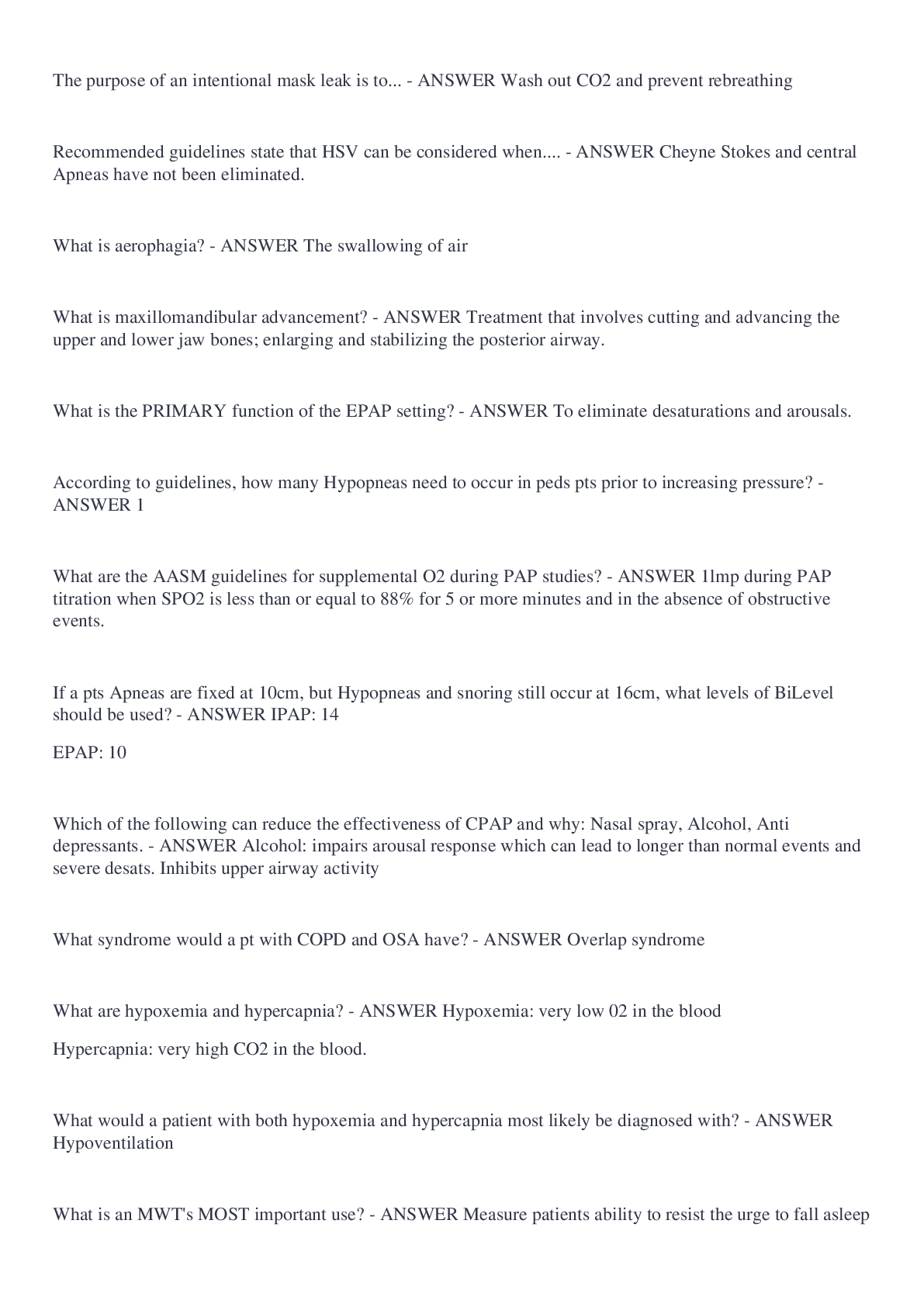



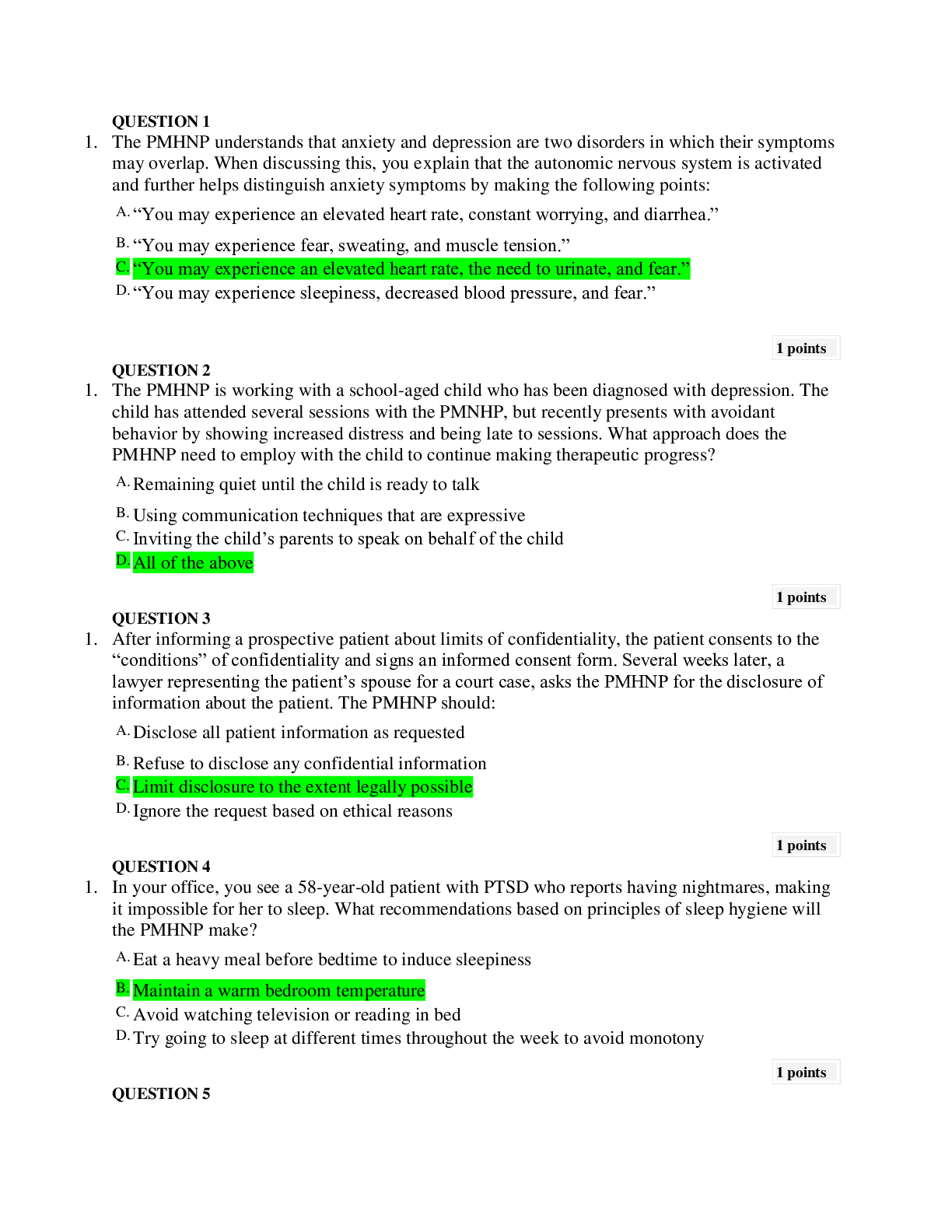
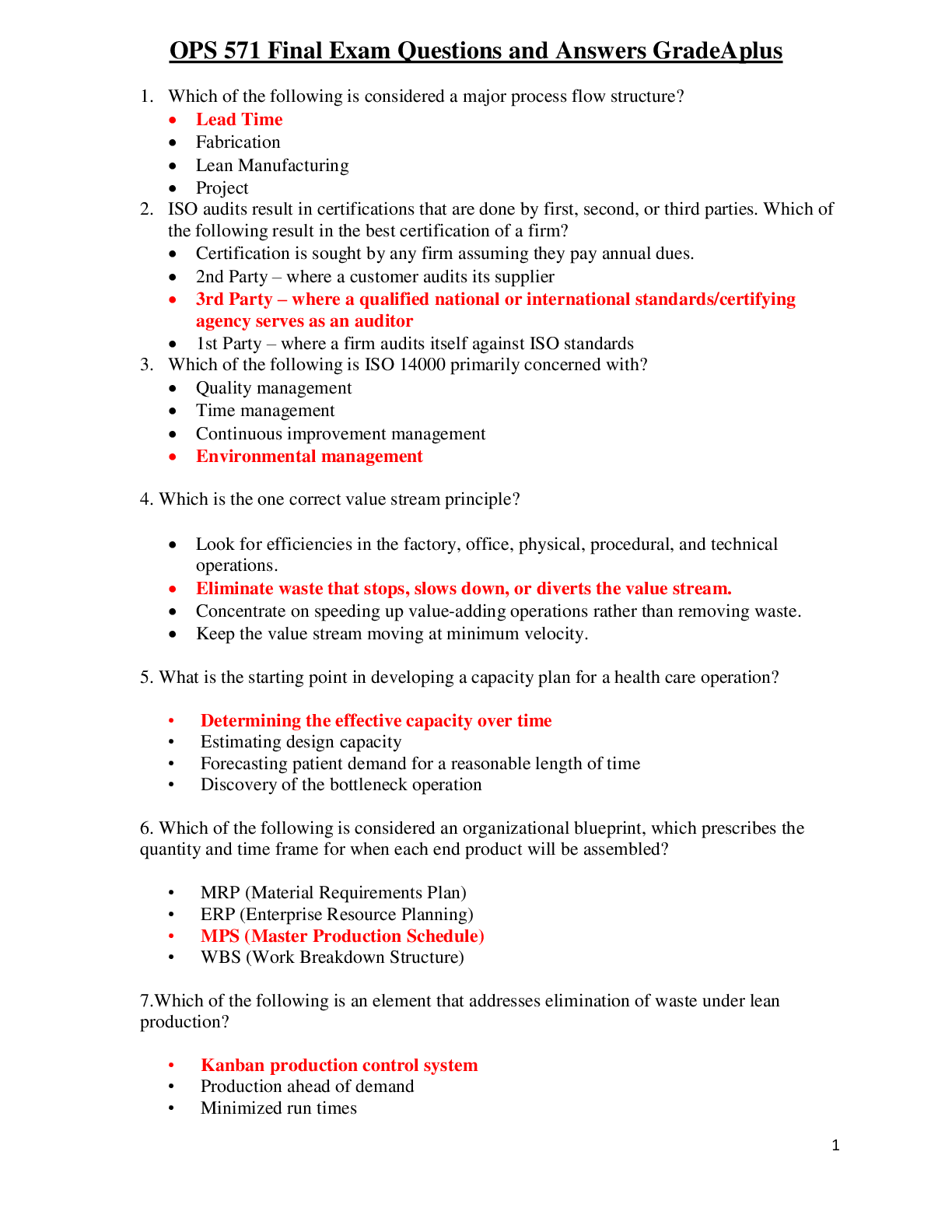
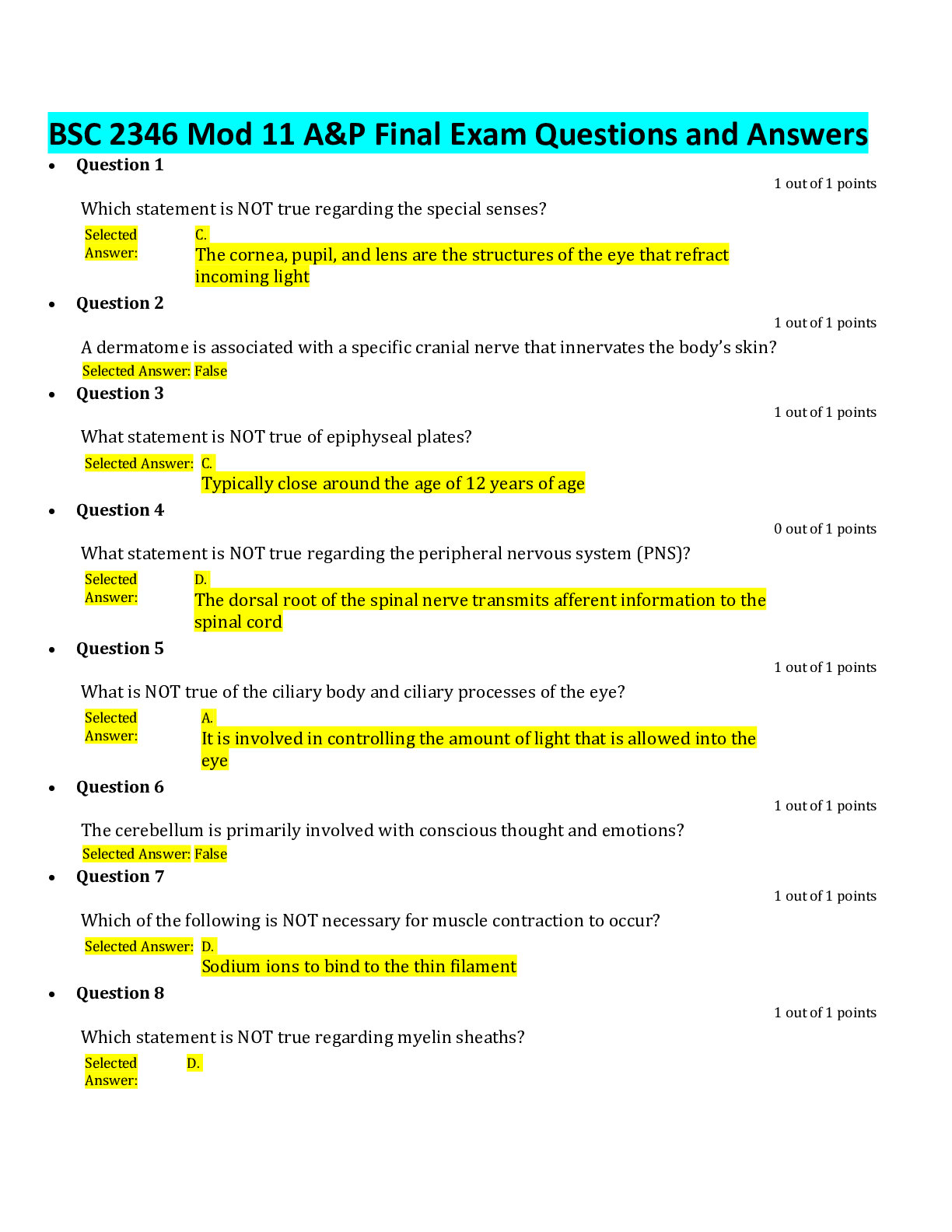


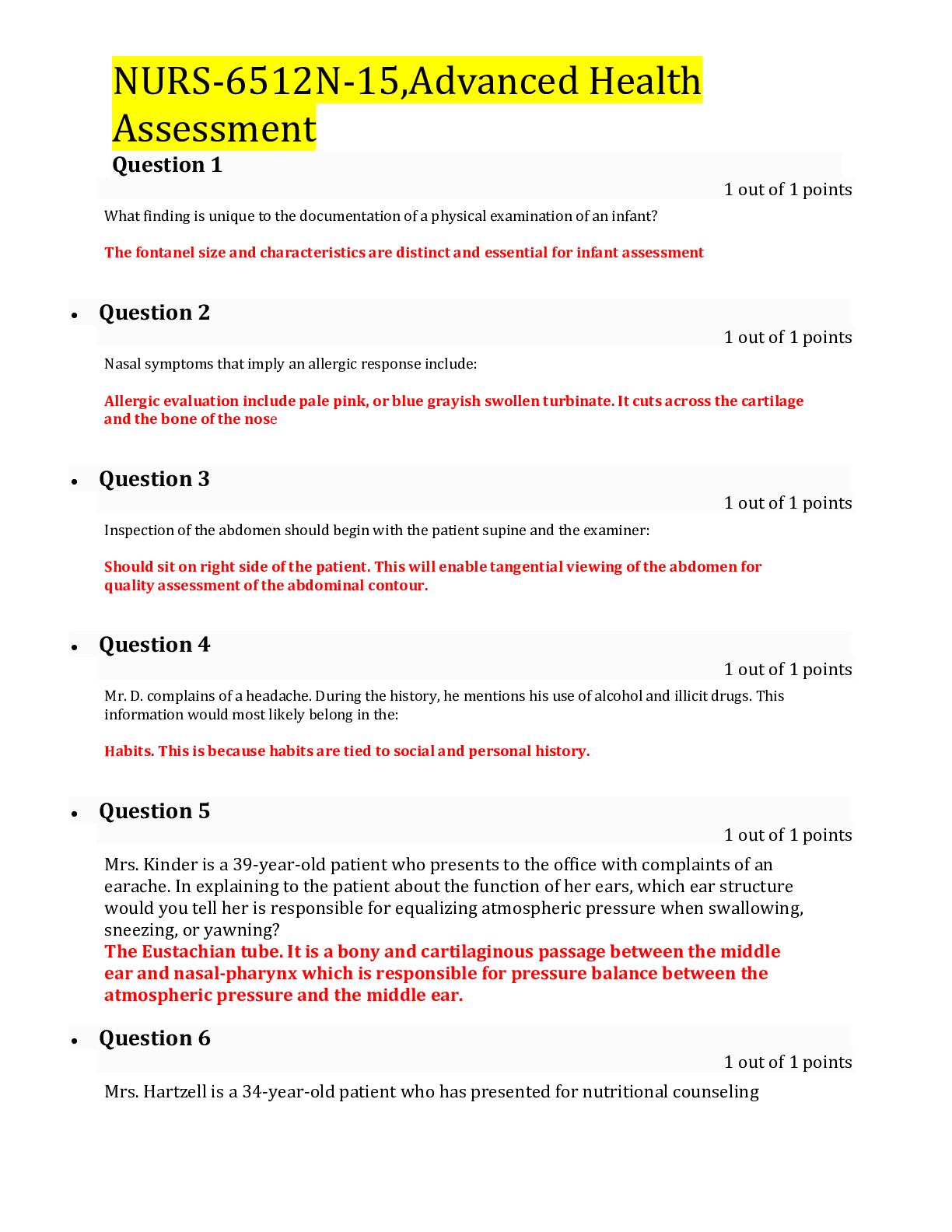
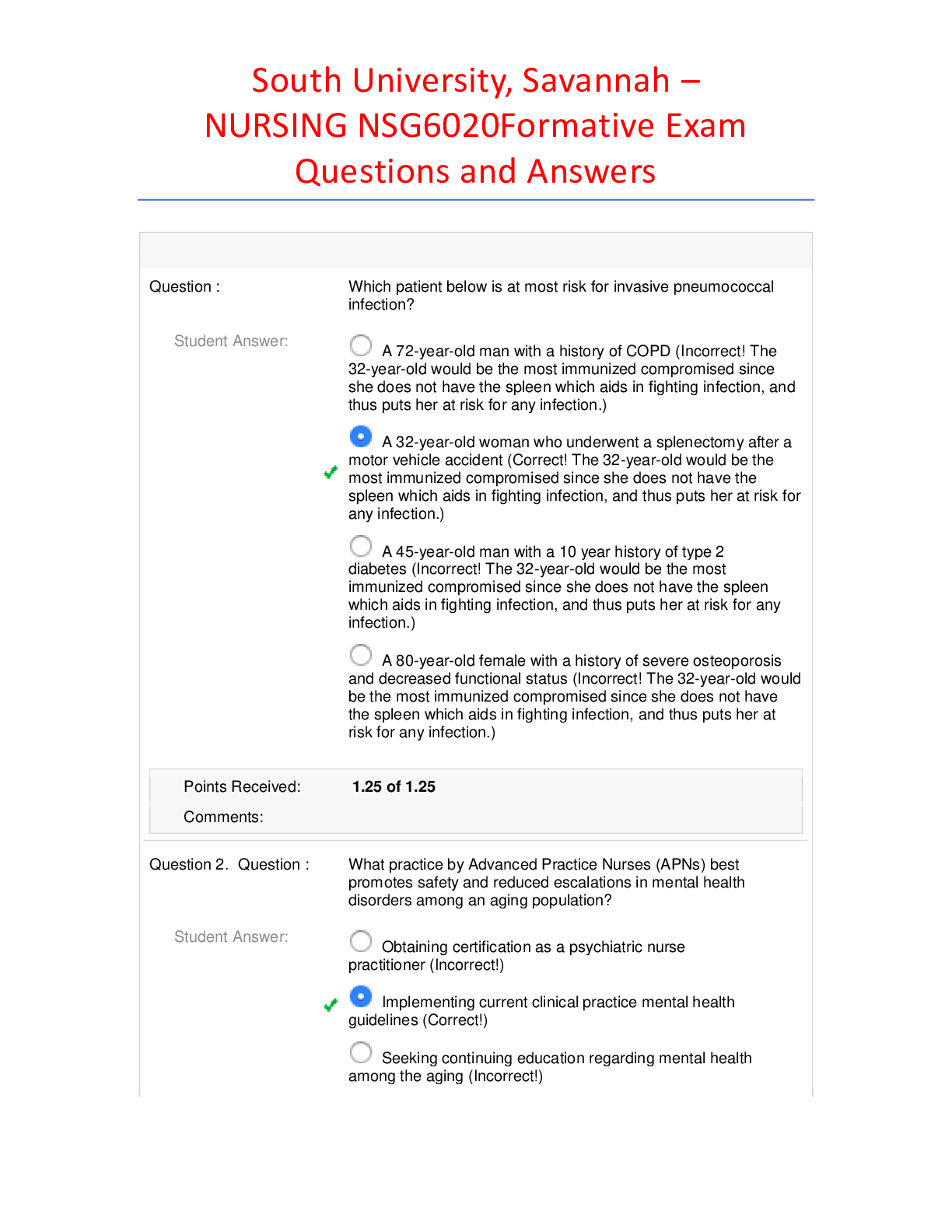
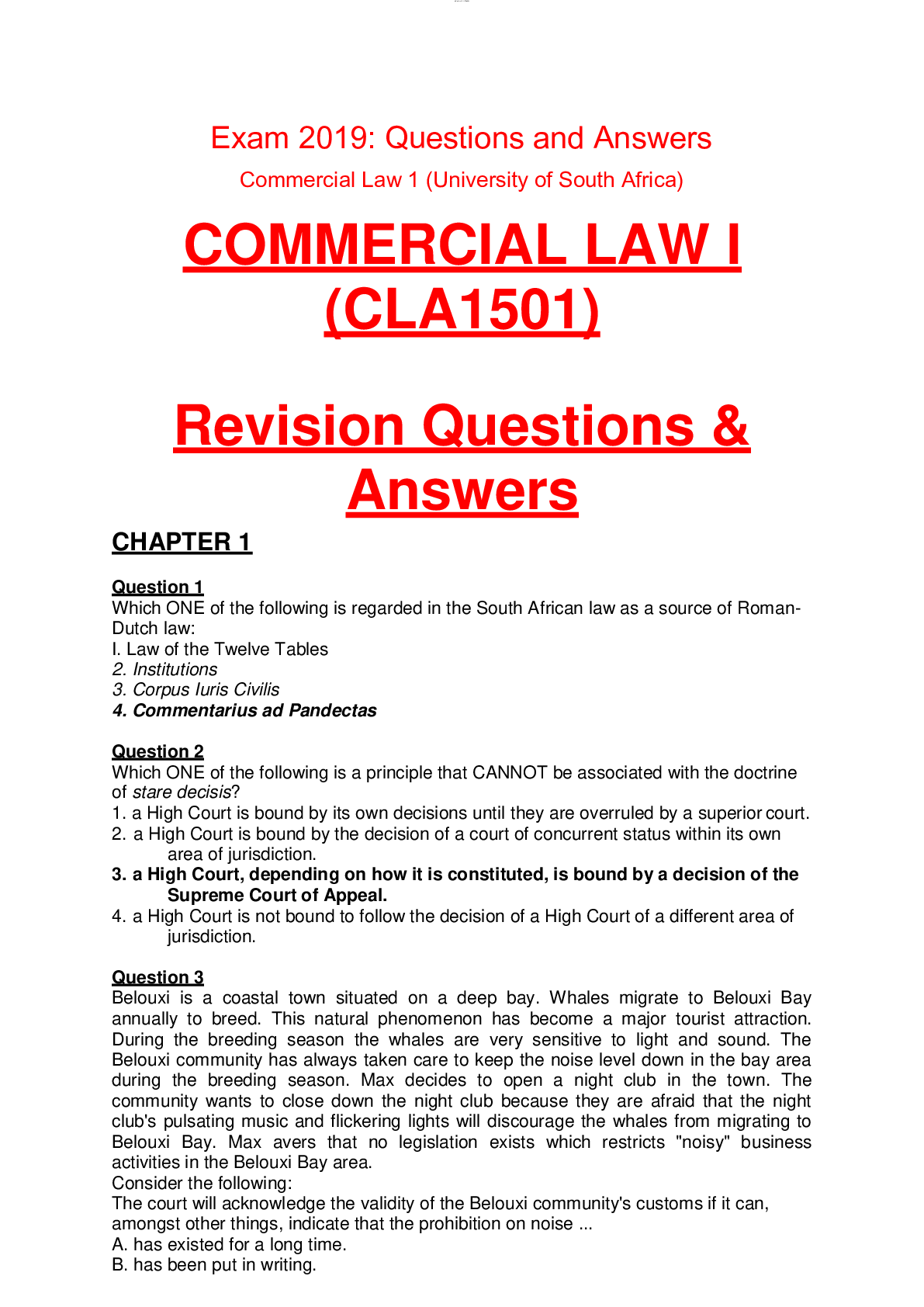

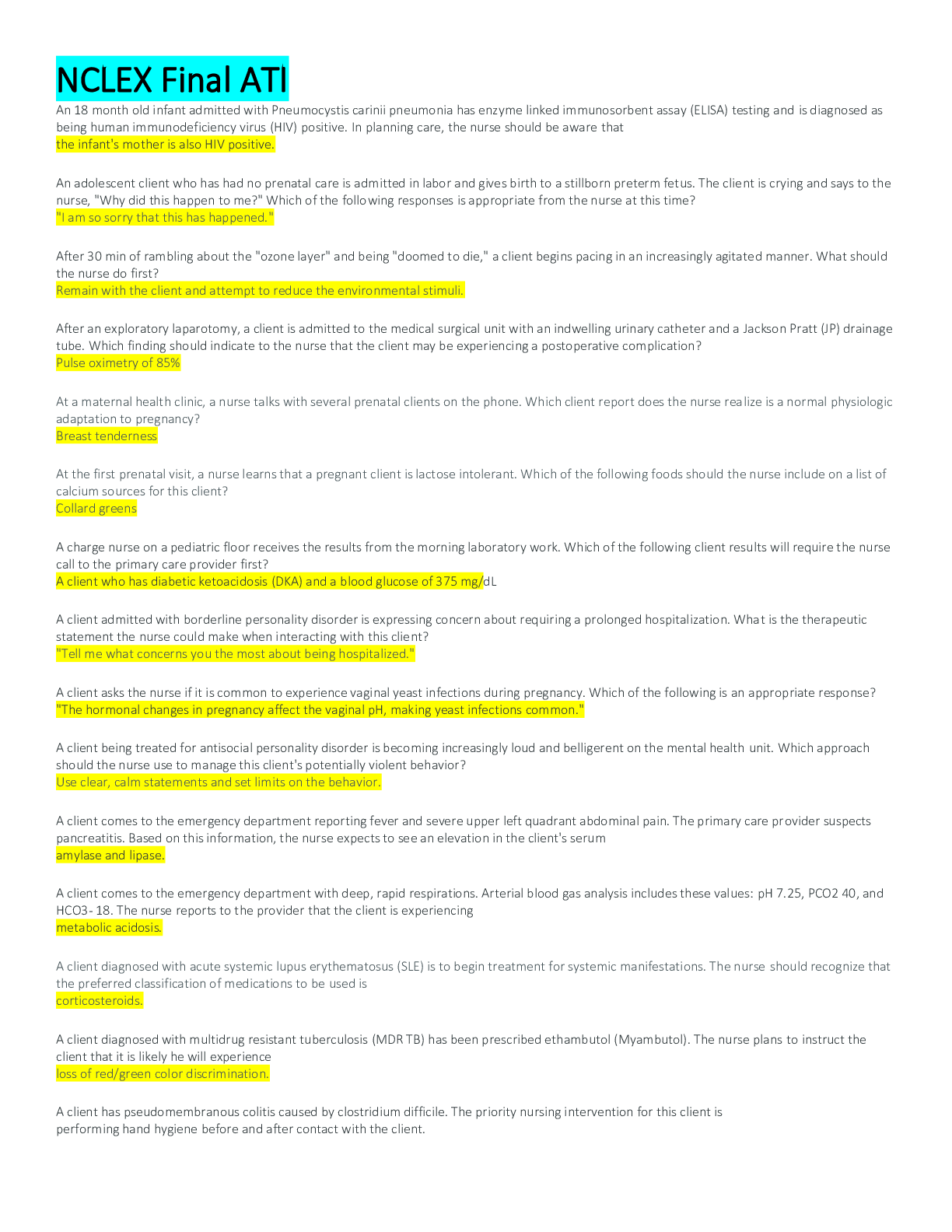
.png)


